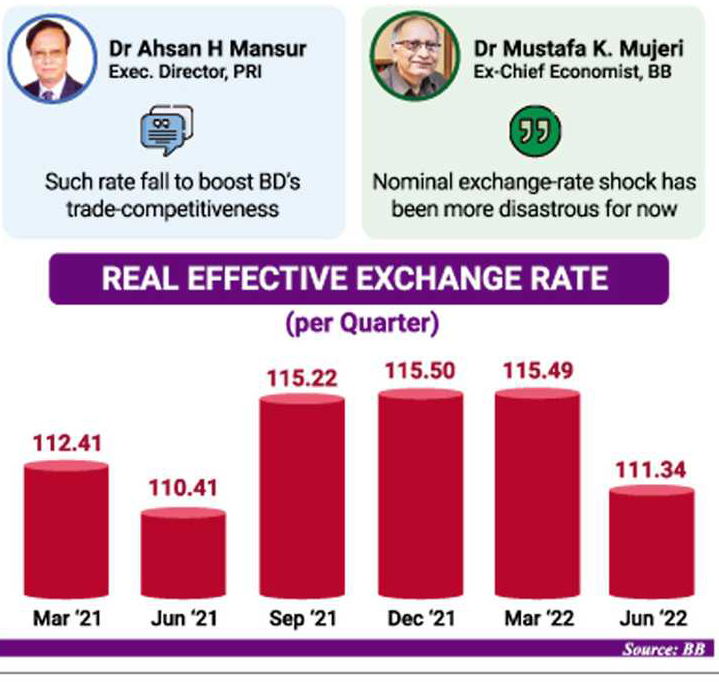
Published :
Updated :

Bangladesh derives some gains from a downturn in the country's real effective exchange rate (REER) recently due to record inflation in its top trading partners that also erodes their currencies' value.
Economists draw such inference from the central bank data on fluctuations in the value of the local-currency taka and reported rates of inflation touching double-digit levels in the trade-partner countries.
However, still the rates remained above the mark of 100, reaching up to 111.48 in July 2022 from 111.34 in June 2022, according to Bangladesh Bank statistics.

The real effective exchange rate or REER is calculated against a basket of currencies of Bangladesh's global trading partners, including the United States of America, China, India, and the European Union.
An increase in a country's REER is an indication that its exports are getting more expensive and its imports cheaper. And its fall indicates vice versa-its exports becoming competitive and imports expensive.
Policymakers and economists view it as an indicator of international competitiveness of a country in comparison with its partners in foreign trade.
Economists believe that decrease in REER indicates that Bangladesh is gaining its competitive edge over its competitors in trade on the global market. But it now still remained much above the 100-count mark.
Dr Ahsan H. Mansur, executive director at the Policy Research Institute of Bangladesh (PRI), told the FE that Bangladesh's trading partners' rates of inflation have been on the climb and Bangladesh's REER on the descent as a result.
Dr Mansur notes that the local currency also has depreciated significantly over the past year and this has contributed much to the index status.
"Such falling trend will boost the country's trade competitiveness," he says.
In addition to the currency value, the factors that are taken into account in calculating the REER value include inflation reading in the country and its trading partners and the value of goods of two trading partners in a third country.
The country's exports increased over 13 per cent to US$12.5 billion during the first quarter (July-September) the fiscal year 2022-23. On the other side of the foreign trade front, imports soared nearly 17 per cent to $13.7 billion during the Q1 of the current fiscal year.
Dr Masrur Reaz, chairman of Policy Exchange of Bangladesh, another local think-tank, told the FE that the drop in the REER is a reflection of a nominal exchange drop.
The nominal exchange rate (NER) has depreciated more than 10 per cent since June 2022. The (interbank Tk-USD exchange rate) in June 2022 was Tk 93.45 and on October 04, 2022 it was Tk 103.62. And the 'kerb-market' rate remained much higher.
Dr Masrur thinks there is a challenging time in terms of REER coming as Bangladesh's inflation has surged fast, especially since August last.
He said the advanced economies have now been pursuing "quantitative tightening" to tighten money flow in their economies.
The rate of inflation of the developed economies will fall due to such belt-tightening measures by their central banks.
He forecast the country's REER may start to rise again in the coming months.
Dr Mustafa K. Mujeri, former chief economist of the central bank - Bangladesh Bank-told the FE that the country's nominal exchange-rate shock has been more disastrous for now.
"The gains attained in the trade competitiveness due to improvement in the REER have been eaten up by the depreciation of the local currency (BDT) against the US dollar."
Dr Mujeri, also executive director of the Inclusive Finance and Development (InM), says the rate of inflation in Bangladesh's top trading partners, including the USA, had accelerated more than Bangladesh's inflation rate, leading to such development in the country's REER.


 For all latest news, follow The Financial Express Google News channel.
For all latest news, follow The Financial Express Google News channel.